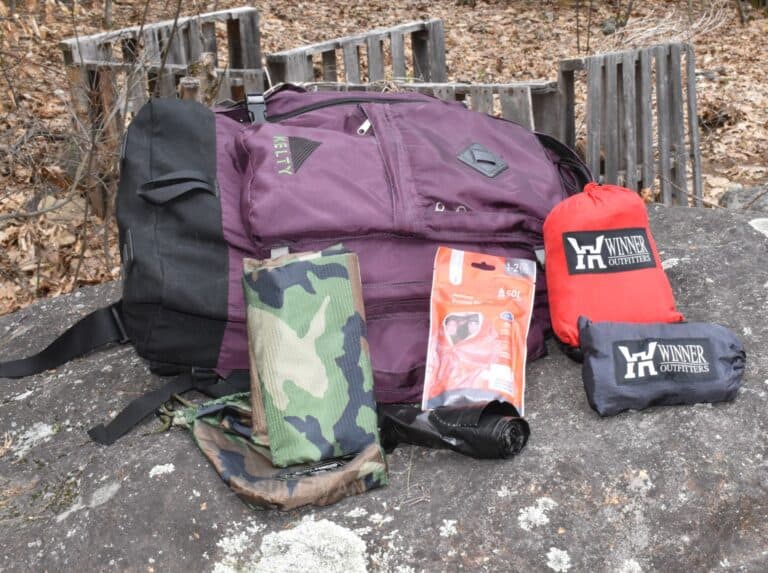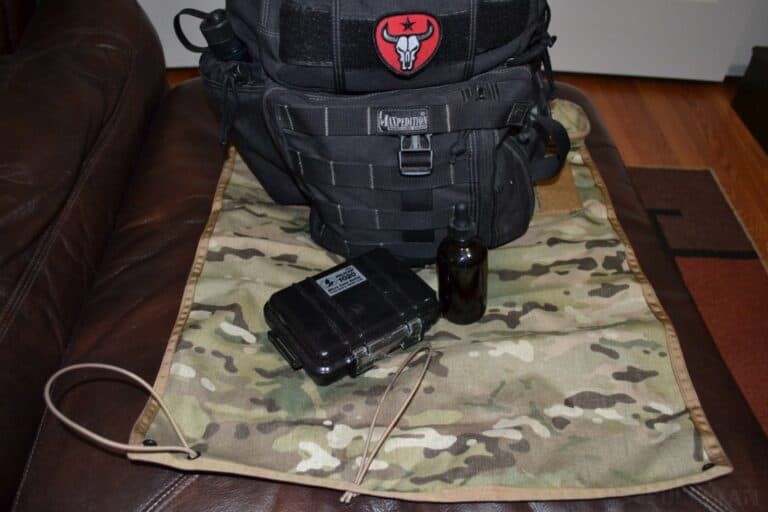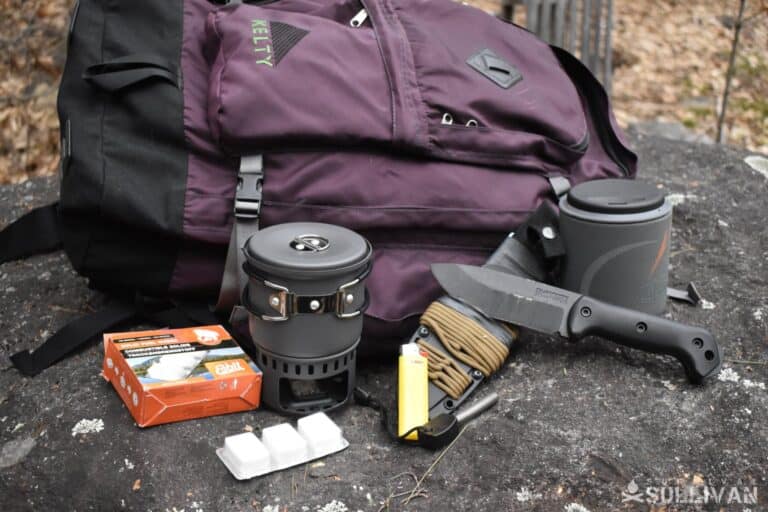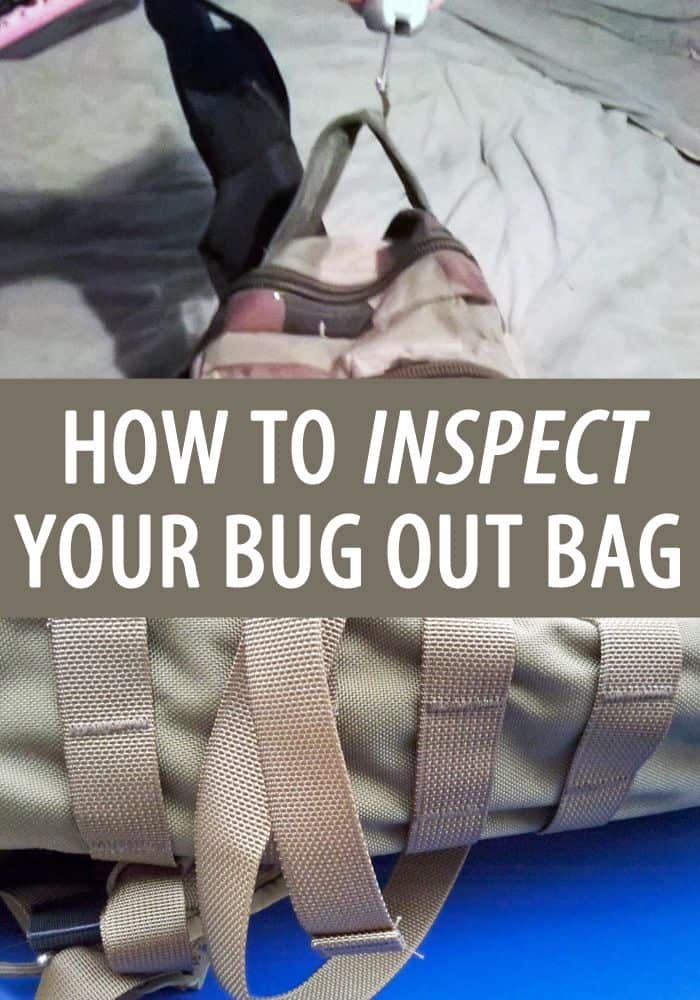A packed BOB features prominently into most preparedness lore and the individual plans of many preppers themselves.
That bag of tricks and tools is akin to your ejection seat or parachute when disaster is looming: grab the handle and go, no fuss, no muss, no scrambling to make ready.

And so most BOBs will sit or lie,packed and ready with all manner of equipment and provision, food and water included, for long periods of time. They wait for that fateful day to arrive even though we hope it never does. Our BOB’s will sit, and sit, and sit; that’s the idea, right?
Yes, but. BOBs and their contents are often neglected when it comes to preventative maintenance checks, and that will wind up coming back to many a prepper to haunt them
In this article, we’ll be looking at the things you should be doing to keep your BOB and its contents in tip-top shape so it is ready to serve in the event that you need to get out of Dodge City.
Table of Contents
Wear, Tear, Spoilage and Breakage
Considering that many BOBs will not be used at all unless they are actively being practiced with, you would be forgiven for thinking that there is not much to do to it besides clean it up every once in a while. Even BOBs that sit in an entryway closet or stay in a vehicle require upkeep, as do the items inside.
Simple rot and mold will readily grow on most fabrics, even modern synthetics, and will over time weaken and eventually rot the fabric.
Temperature cycles are especially hard on bags that are kept in vehicles, and also hard on the shelf life and stability of foodstuffs. Medications may go bad or lose effectiveness over time. Batteries slowly discharge, or leak.
All kinds of things happen to and in your BOB that require your care and attention to fix. Your BOB is not a child or pet; it definitely does not need constant attention and care.
But just like anything else that is kept on a ready line for immediate deployment is expertly maintained to ensure that level of instant readiness, you should treat your BOB the same as any automobile, helicopter or firearm and give it the care it deserves.
In the following sections I’ll detail a few different areas of concern on your BOB and its contents. Forewarned is forearmed, and with a few reminders you can spiffy up your BOB and rotate degradable items quickly and easily.
A Word on Quality
If you can afford it, quality is always a good investment. This is very true for packs, especially ones that will be loaded heavy and carried often and fast. Anyone who has overloaded a cheap backpack, even a little, will tell you all the little snap-pop-skreeitch of busting strap stitching when they went to shoulder the bag.
Running for your life with a load on your back in the middle of a God-awful disaster is no time to find out your, ah, thrifty back pack has given up the ghost less than 2 miles from your front door.
You do not have to use a $500 pack from a boutique maker or one that is actually issued to elite forces to get a reliable, sturdy pack, but you also should not be expecting your$20 no-name flea market pack to do much more than hold a couple of pairs of socks.
As always, there is a happy middle ground on quality and performance. Buy as nice a pack as you can afford, and then test it. Load it up a little in excess of your actual load out weight and then give it a good workout. If it can withstand several outings like that, it will in all likelihood work just fine in an actual event.
You won’t really know what your BOB as well as yourself can or cannot do with anything less.

The Bug Out Bag Itself
Your biggest concern with your bag will be wear from use, and mold from moisture and exposure to dirt and grime. Both are problematic, but also thankfully easy to prevent.The first step is simply inspecting your bag carefully with intention.
Wear can take the form of loose or broken stitching leading to strap, belt or panel failure, or cuts and tears in the shell or other compartments. Every time you grab your pack by handle or strap you will put strain on it.
Over time, the stitching will loosen or fray, resulting in that same handle or strap coming loose and dumping your BOB (and perhaps its contents) all over the road. Abuse and dirt or grit working into the fabric can also lead to wear, causing a blowout, thusly ruining your pack and also spilling its contents.
To prevent this embarrassing and hindering occurrence, simply make it a point to look over your BOB after you practice with it heavily.
If you notice any of the above symptoms, have the pack repaired if possible or get a replacement. Any manufacturer of high-quality packs will likely offer a repair service, and will definitely be able to advise you if your BOB is beyond saving.
Your other major issue of concern is the growth of mold or other microscopic life on your pack. Aside from being an occasional health hazard, these microbial outbreaks can accelerate wear.
You’ll usually see these flourish on pack that has gotten wet, dirty, bloody or nasty in some other way and then be put away accordingly. This can also happen to clean packs kept in dark,dank conditions.
Prevention is the best defense here,as some infestations are shockingly hard to remedy thanks to the density of modern fabrics, to say nothing of all the little nooks and crannies inherent to the average backpacks construction. Once established, you will always be waiting for it to flare back up.
If you do notice mold or other gribblies growing on your pack, you’ll need to clean it off posthaste. Use a commercial cleaning solution and stiff brush or whip-up some home brew cleaner (you can find plenty of mixes on the internet that will vary depending on what fabric you are treating) and go to town.
Give it the affected and surrounding areas on your BOB a thorough scrubbing, rinse with fresh, clean water and then place it in the sun to dry out really well.
With a little bit of attention, your BOB will offer years of dependable service.

Caring for Contents
The content of your BOB also require care and attention. The most obvious items carried that need rotation are food, potable water and medicines. Batteries have a long shelf life, but even quality lithium batteries do lose power over time. Cycles of hot and cold exacerbate rotation of all of the above to one extent or another.
When it comes to food, the sell or use by dates are often times just guidelines. YouTube is full of adventurous types who eat all kinds of things that are well beyond the “toss” date on the packaging and they all turn out fine.Mostly.
If you don’t want to take any chances with such things, and you shouldn’t, simply eat or rotate your rations according to a reminder set on your calendar or phone. You can make your life a little easier in this regard by choosing foodstuffs that are temperature stable and store well.
Water also requires rotation, especially if you keep your ready supply in a refillable water bottle. Most spring and purified commercial waters will keep quite along time, but lengthy storage times combined with exposure to high temperature can degrade the seals on typically flimsy bottles.
At best, this leads to poor taste, but at worst could see harmful chemicals leach into the water from their containers.
If you keep your personal water bottles topped up with water, you’ll need to rotate the supply pretty regularly: no matter how thoroughly you clean and sterilize your bottle, it seems a few stray germs always wind up in there with your water.
Over tim,e you will probably notice an odd smell or taste when opening the bottle, but if you leave a clear bottle in the sun for any length of time you can actually get and bloom of algae inside!
This algae is not harmful, at least not according to my limited research, but is certainly off-putting. You can prevent any weirdness from happening with any water source in your BOB by rotating them regularly.
Any of your packed devices that use batteries as well as all the spares you carry, including but not limited to flashlights, phones, gun sights, GPS systems, radios and power banks, should be regularly swapped or recharged.
How often depends on how much drain the batteries undergo, and this drain is influenced by things like battery health and quality, temperature and so on.
You do not need to swap them every week or even every quarter, but you should be taking a keen interest in just how much juice you can get from batteries on standby. Any device that has a power gauge should be consulted regularly to help you get a better idea of how much power you are losing on standby.
If you are really serious, or just want to save money over the long haul, you can purchase a battery tester that will analyze the remaining charge and overall health of the battery.
When it comes to spare battery selection, there are plenty of times you will not have any choices with equipment that uses a specific type of battery, or has a built in battery. For everything else that uses a standard size of battery, you will usually have a choice between alkaline and lithium batteries.
Both have their pros and cons, but the biggest difference is the shelf life and resiliency of the battery to resist charge loss. Alkaline batteries work fine and provide plenty of power, but lose their charge quicker over time than lithium batteries.
Lithium batteries also have the perk of being more resilient to temperature shifts than alkaline batteries. Whichever you settle on, take pains to keep them out of temperature extremes and rotate them out for fresh spares once a year.
Other Tips
When storing your BOB anywhere, be sure to keep the BOB itself and the immediate area free of debris that will attract pests, mammalian or insect.
Rats and mice will nibble through any material in no time flat in search of food or warm nesting grounds, and ants are famous for their proclivity to swarm into places on the heels of a lone scout that returned with a Kit-Kat crumb.
You should also periodically remove, inspect and function check all tools and equipment in the BOB.
Sure, even toting your BOB on a practice ruck or hike does not mean you’ll be deploying its contents, but constant movement and abrasion, not to mention drops and bumps, can take its toll on many things. The items in your BOB are not in stasis; check on them from time to time for function and performance.
The last tip I’d give you is to keep an eye on all buckles, clasps and fasteners, including ones that you are suing to secure or lash gear to the pack.
On a quality pack, the parts that are most vulnerable to failure are typically these fasteners. If your connection points are showing cracks, chips or impeded function do not wait: have them swapped with OEM or better replacements.
Ready to Inspect It?
Don’t let your trusty BOB sit and molder away from a lack of care and inspection. Your BOB certainly deserves regular preventative maintenance the same as any other piece of gear you own.
By inspecting your BOB, keeping it clean, fresh and evaluating and if necessary replacing consumables you will ensure you are at peak material readiness when the SHTF. Anything less may see your ace in the hole turn out to be a pair of deuces.


Charles Yor is an advocate of low-profile preparation, readiness as a virtue and avoiding trouble before it starts. He has enjoyed a long career in personal security implementation throughout the lower 48 of the United States.

loto of info. too much reading with no suggestions on good lowcost packs. really a waste of my time.j
Alyce packs…Ton of them around. They are pretty cheap and made tough. They have been used for decades by the military. I have 2. BUT… use a dry bag inside it to make sure the items that are meant to stay dry, stay dry.
Awesome article… If people are going through their BOBs to keep up with seasonal changes then this should be a no-brainer… I just went through mine last night and found that my wife’s bag got wet from stored water that leaked…
The change-over from summer bits (like bug spray and mosquito netting) to winter stuff (like hand warmers and wool socks) seems to be a frequent enough review of the contents. Twice a year, at the change-over, I pull everything out on the living room floor of both mine and my wife’s packs. Give everything a look.
Food goes bad pretty quickly (at least develops an ‘off’ taste, even if still okay) So, food and water are usually cycled out more frequently. Keeping those at the top (or outside pocket) makes that easy.
Another goal at these spot checks is for weight-loss options. Any pound saved is less strain on the pack and the wearer.